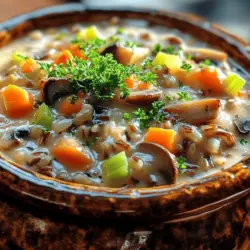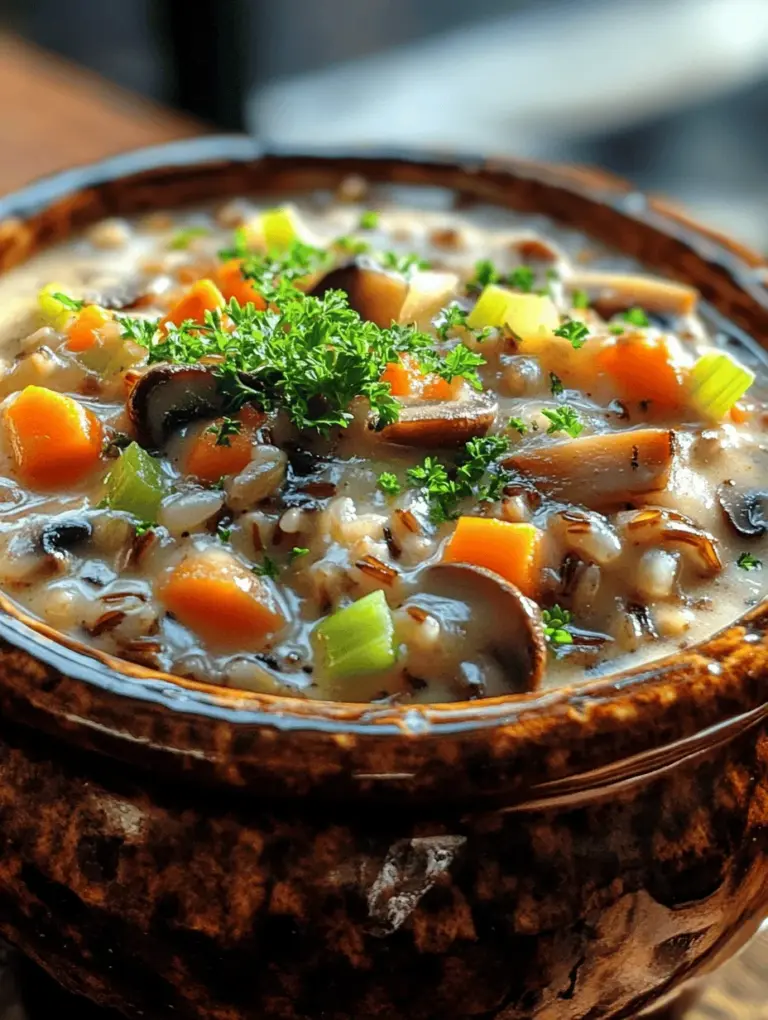Understanding the allure of a warm, hearty bowl of soup is a universal experience. Whether it’s a chilly evening or a rainy day, there’s something deeply comforting about holding a steaming bowl of soup in your hands. Among the myriad of soup options available, nothing embodies this comfort better than a Wild Rice and Mushroom Soup. This recipe is not only simple to prepare but is also packed with nutrients and rich flavors, making it an ideal choice for a cozy dinner or a nourishing lunch. In this article, we will explore the origins of wild rice, highlight the health benefits of mushrooms, and provide a comprehensive guide to making this delightful soup from scratch.
The Nutritional Value of Wild Rice and Mushrooms
The Health Benefits of Wild Rice
Wild rice, often considered a delicacy, is not actually rice but the grain of an aquatic grass. Native to North America, it has been cultivated and harvested by Indigenous peoples for centuries. The allure of wild rice goes beyond its unique nutty flavor and chewy texture; it also boasts impressive health benefits:
– Rich in Antioxidants: Wild rice is packed with antioxidants, which help combat oxidative stress in the body. These compounds can play a role in reducing the risk of chronic diseases and promoting overall health.
– High in Fiber and Protein: With more fiber and protein than traditional white rice, wild rice is an excellent choice for those looking to enhance their diet. Fiber aids in digestion and helps maintain a healthy weight, while protein is crucial for muscle repair and growth.
– Gluten-Free Alternative: For those with gluten sensitivities or celiac disease, wild rice serves as a nutritious gluten-free alternative to traditional grains. It’s a versatile option that can be incorporated into various dishes, making it a staple in many gluten-free diets.
The Nutritional Profile of Mushrooms
Mushrooms are another powerhouse ingredient in this soup, bringing a wealth of nutritional benefits to the table. These fungi are not only delicious but also highly nutritious:
– Low in Calories but High in Nutrients: Mushrooms are low in calories, making them an ideal addition for anyone looking to maintain a healthy weight. Despite their low calorie content, they provide essential nutrients that support overall health.
– Source of Vitamins D and B: Mushrooms are one of the few non-animal sources of vitamin D, which is vital for bone health and immune function. They are also rich in B vitamins like riboflavin, niacin, and pantothenic acid, which help convert food into energy and promote healthy skin.
– Immune-Boosting Properties: Certain varieties of mushrooms, such as shiitake and maitake, have been linked to enhanced immune function. They contain beta-glucans, which may help the body fight off infections and diseases.
Choosing the Right Ingredients
To create a truly exceptional Wild Rice and Mushroom Soup, selecting the right ingredients is crucial. The quality and freshness of your components will directly impact the flavor and nutritional profile of the finished dish.
Selecting Wild Rice
Wild rice comes in several varieties, each with distinct flavors and textures. The most common types include:
– Natural Wild Rice: This is the most traditional type, often harvested from lakes and rivers. It has a robust flavor and a chewy texture.
– Cultivated Wild Rice: While still delicious, cultivated wild rice tends to be milder and softer than its natural counterpart. Both types can be used interchangeably in most recipes, but it’s essential to check the cooking times, as natural wild rice may take longer to cook.
Tips for Rinsing and Preparing Wild Rice: Before cooking, it’s advisable to rinse wild rice under cold water to remove any debris or dust. This step also helps enhance its nutty flavor. After rinsing, soak the rice for at least 30 minutes to ensure even cooking, especially if using natural wild rice.
Understanding the Role of Mushrooms
Mushrooms play a central role in the flavor profile of this soup, bringing depth and umami richness. There are several types of mushrooms you can choose from, including:
– Cremini Mushrooms: Also known as baby bellas, these mushrooms are versatile and have a slightly stronger flavor than white button mushrooms. They add a robust taste to the soup.
– Shiitake Mushrooms: Known for their rich, savory flavor, shiitake mushrooms can elevate the soup’s umami notes. They are also packed with nutrients and health benefits.
– Porcini Mushrooms: If you’re looking for an intense flavor, dried porcini mushrooms are an excellent choice. They can be rehydrated and added to the soup for an earthy, aromatic profile.
How to Choose and Store Fresh Mushrooms: When selecting fresh mushrooms, look for firm, plump specimens with a smooth surface. Avoid any that appear slimy or have dark spots. Store mushrooms in a paper bag in the refrigerator to maintain their freshness, as plastic can trap moisture and lead to spoilage.
Essential Aromatics: Onion and Garlic
No soup is complete without the foundational flavors provided by aromatics. Onions and garlic are essential in building the flavor base for this Wild Rice and Mushroom Soup.
– The Importance of Aromatics in Building Flavor: Aromatics not only add depth to the soup but also enhance the overall taste experience. Sautéing onions and garlic creates a fragrant base that complements the earthy flavors of the mushrooms and wild rice.
– Tips for Selecting and Preparing Onions and Garlic: Choose firm onions with papery skins, avoiding any that are soft or sprouting. For garlic, look for bulbs that are plump and free of blemishes. When preparing, finely chop the onions and mince the garlic for even distribution in the soup.
Fresh Vegetables for Balanced Nutrition
Incorporating fresh vegetables is essential for creating a balanced and nutritious soup. Carrots and celery are classic additions that provide sweetness and crunch.
– Benefits of Including Carrots and Celery: Carrots add natural sweetness and are rich in beta-carotene, which converts to vitamin A in the body. Celery contributes a refreshing crunch and is low in calories while being a good source of hydration.
– How to Cut and Prepare These Vegetables: For even cooking, dice the carrots and celery into uniform pieces. Typically, a medium dice (about 1/4 inch) works well. This size allows them to cook through without becoming mushy, maintaining a pleasant texture in the finished soup.
Cooking Techniques and Preparation
Now that we’ve covered the essential ingredients, it’s time to dive into the cooking techniques that will bring your Hearty Wild Rice and Mushroom Soup to life. The following steps will guide you through the preparation and cooking process, ensuring that you achieve a flavorful and satisfying result.
1. Sautéing the Aromatics: Begin by heating a generous drizzle of olive oil in a large pot over medium heat. Once hot, add the chopped onions and sauté until they become translucent, about 5-7 minutes. Next, add the minced garlic and sauté for an additional minute, just until fragrant.
2. Cooking the Mushrooms: Add your chosen mushrooms to the pot and cook until they release their moisture and begin to brown, about 5-10 minutes. This step is crucial for developing the rich, savory flavor that characterizes the soup.
3. Incorporating the Vegetables: Stir in the diced carrots and celery, allowing them to soften for about 5 minutes. This will add layers of flavor and texture to the soup.
4. Adding the Wild Rice: Rinse the soaked wild rice and add it to the pot, stirring to combine. This step ensures that the rice absorbs all the delicious flavors from the sautéed ingredients.
5. Pouring in the Broth: Finally, add vegetable or chicken broth to the pot, ensuring all the ingredients are covered. Bring the mixture to a boil, then reduce the heat to a simmer. Cover the pot and let it cook for approximately 40-45 minutes, or until the rice is tender and has burst open.
6. Finishing Touches: Once the soup is cooked, taste and adjust the seasoning with salt and pepper as needed. You can also add a splash of lemon juice or a sprinkle of fresh herbs (like thyme or parsley) for an extra burst of flavor.
This hearty soup not only nourishes the body but also warms the soul, making it a perfect dish for any occasion. Stay tuned for the next part of this article, where we’ll dive deeper into serving suggestions, variations of the recipe, and tips for achieving the best results.
{{image_1}}
Effective Sautéing: Building Flavor Layers
Sautéing is a fundamental technique in cooking that helps build flavor layers, especially in a hearty soup like Wild Rice and Mushroom Soup. The process begins with the humble onion and garlic, which are the aromatic backbone of many dishes.
The Science Behind Sautéing Onions and Garlic
When you sauté onions, you initiate the Maillard reaction, which occurs when the sugars in the onions caramelize and transform into complex flavors. This process not only enhances the sweetness of the onions but also adds depth to the overall taste of the soup. Garlic, on the other hand, releases its essential oils when gently sautéed, imparting a rich, aromatic flavor that complements the earthiness of mushrooms and the nuttiness of wild rice.
To achieve the best results, heat a generous amount of olive oil in a large pot over medium heat. Add the chopped onions first, allowing them to cook for about 5-7 minutes until they become translucent and slightly golden. Next, introduce minced garlic and sauté for an additional 1-2 minutes. Be cautious not to burn the garlic, as it can turn bitter and overpower the dish.
Importance of Cooking Mushrooms Until Browned
Mushrooms are a key ingredient in this soup, and their preparation is crucial for maximizing flavor. Cooking mushrooms until they are browned helps to develop their natural umami qualities. This process, known as the Maillard reaction as well, enhances their taste and texture, transforming them from spongy to meaty.
Once the onions and garlic are fragrant, add the sliced mushrooms to the pot. Sauté them for about 8-10 minutes, stirring occasionally, until they have released their moisture and turned a beautiful golden brown. The browning not only intensifies the flavor but also adds a delightful texture to the soup.
Simmering to Perfection
Simmering is the next step in creating a well-balanced soup. This method allows the flavors to meld together, resulting in a cohesive and hearty dish.
How Simmering Enhances Flavors
When you simmer the ingredients, you encourage the release of flavors from the vegetables, herbs, and spices. The gentle heat helps the wild rice to cook thoroughly while allowing the soup base to deepen in flavor. To achieve the best results, bring your soup mixture to a boil after adding the broth, then reduce the heat to low and let it simmer gently. This slow cooking process is essential, as it encourages the rice to absorb the broth, resulting in a creamy, rich texture.
Tips for Achieving the Ideal Soup Consistency
For the perfect consistency, aim for a balance between creamy and brothy. If you prefer a thicker soup, consider using less broth or adding a cornstarch slurry (a mixture of cornstarch and cold water) to thicken it as it simmers. Conversely, if you find your soup too thick, simply add more vegetable broth or water until it reaches your desired consistency. Remember to taste and adjust the seasoning throughout the simmering process to ensure the flavors are well-balanced.
Incorporating Creaminess: Heavy Cream vs. Coconut Milk
Creaminess is a crucial component of this wild rice and mushroom soup, providing a luxurious mouthfeel that complements the earthy flavors of the ingredients.
Exploring the Differences Between Dairy and Dairy-Free Options
You have the option to use heavy cream for a rich, indulgent soup or coconut milk for a lighter, dairy-free alternative. Heavy cream adds a velvety texture and richness that enhances the overall flavor profile. If you prefer a dairy-free option, coconut milk introduces a subtle sweetness and creaminess while keeping the dish vegan-friendly.
How to Properly Integrate Cream into the Soup
When adding cream or coconut milk, it’s important to do so at the right time to prevent curdling. Once the soup has simmered and the wild rice is cooked, remove the pot from heat before stirring in the cream or coconut milk. This gentle incorporation allows the cream to blend smoothly without the risk of separation. Stir until fully combined and adjust the seasoning if needed; a pinch of salt or a squeeze of lemon can elevate the flavors beautifully.
Serving Suggestions and Pairings
Ideal Accompaniments for Wild Rice and Mushroom Soup
To elevate your dining experience, consider serving your Hearty Wild Rice and Mushroom Soup with a variety of delightful accompaniments.
– Bread Options: A crusty baguette or sourdough bread is perfect for dipping, while gluten-free bread can cater to dietary restrictions. The texture of the bread contrasts beautifully with the creamy soup, making each bite satisfying.
– Fresh Salads: Pairing the soup with a fresh salad not only adds color to your plate but also enhances the meal’s nutritional value. A simple mixed greens salad with a light vinaigrette or a hearty kale salad with nuts and dried fruits complements the rich flavors of the soup.
Creative Presentation Ideas
Presentation matters, and even the simplest soups can look elegant with a few thoughtful touches.
– Garnishing Techniques: A sprinkle of fresh parsley not only adds a pop of color but also a fresh flavor that brightens the dish. For an added touch, consider drizzling a bit of olive oil or a swirl of cream on top before serving.
– Rustic Table Setting: Serve the soup in rustic bowls to enhance the homey feel of the meal. Consider using wooden cutting boards or simple linen napkins to create a warm, inviting atmosphere that encourages shared meals and conversation.
Storing and Reheating the Soup
Best Practices for Storing Leftovers
Leftover soup can be a lifesaver for busy days. To store your Hearty Wild Rice and Mushroom Soup effectively, follow these guidelines:
– Refrigeration: Allow the soup to cool to room temperature before transferring it to an airtight container. It can be stored in the refrigerator for up to 5 days.
– Freezing: For longer storage, freezing is an excellent option. Place the cooled soup in freezer-safe containers or resealable bags, leaving some space for expansion. Frozen soup will maintain its quality for up to 3 months.
Tips for Extending the Shelf Life of the Soup
To maximize the shelf life, consider portioning out the soup before freezing. This way, you can thaw only what you need, reducing waste. Additionally, avoid adding cream to the entire batch if you plan to freeze it. Instead, add cream to individual servings after reheating to maintain the best flavor and texture.
Reheating Techniques
When it’s time to enjoy your leftovers, reheating the soup properly is key to preserving its deliciousness.
Recommended Methods for Reheating Without Losing Flavor
– Stovetop: The best way to reheat soup is on the stovetop. Pour the desired amount into a saucepan, and heat over medium-low heat, stirring occasionally. This method allows for even heating without losing the soup’s integrity.
– Microwave: If you’re short on time, a microwave can work. Place the soup in a microwave-safe bowl, cover it with a microwave-safe lid or a paper towel, and heat in 1-minute intervals, stirring in between, until hot.
Adjusting Consistency When Reheating
As the soup may thicken in the refrigerator, you may need to adjust the consistency when reheating. Simply add a splash of vegetable broth or water to reach your desired thickness. Taste and adjust the seasoning if necessary, as flavors may mellow during storage.
Conclusion
In conclusion, the Hearty Wild Rice and Mushroom Soup is not just a meal; it is a celebration of wholesome ingredients that come together to create a comforting dish. With its rich flavors and nutritional benefits, this soup is perfect for any occasion, from weeknight dinners to gatherings with friends and family. By mastering this recipe, you not only create a delightful culinary experience but also embrace a healthier lifestyle through nourishing food. Enjoy the process, savor each bite, and let this soup warm your heart and soul. Whether served on a chilly evening or as a part of a festive gathering, this soup is sure to impress and satisfy all who partake.


